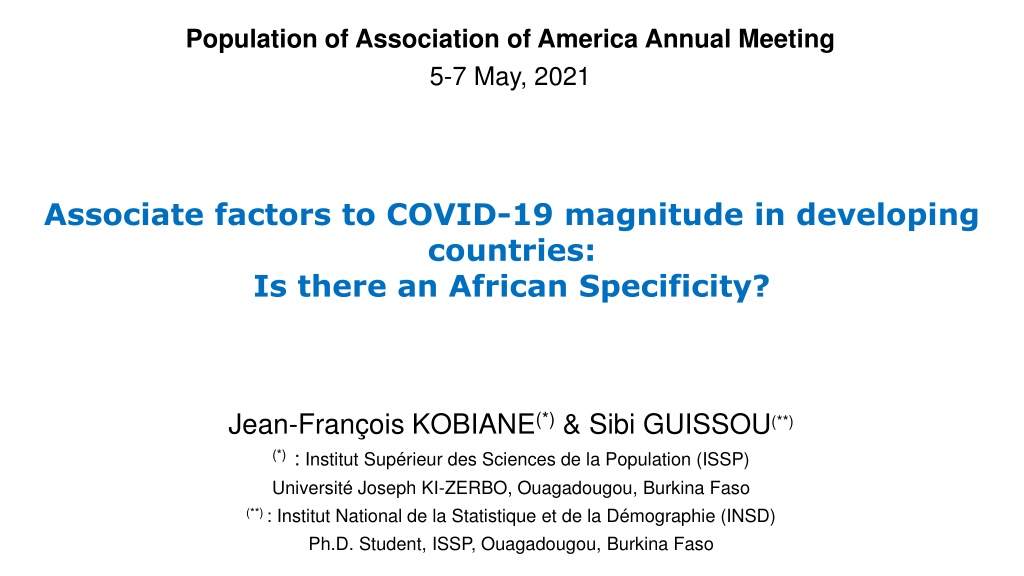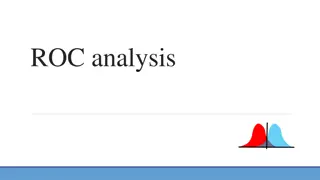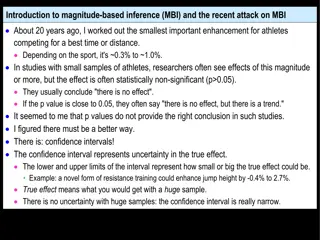Factors Influencing COVID-19 Magnitude in Developing Countries: African Specificity
An exploration of factors influencing the magnitude of COVID-19 in developing countries, with a focus on any African specificity. The study uses diverse data from various developing countries to investigate the impact of demographic, economic, social service access, environmental, climatic, and health-related variables. The analysis includes 104 countries from Africa, Asia, Latin America, and the Caribbean, with a particular emphasis on the African continent. Preliminary findings aim to shed light on potential reasons for the varying impact of the pandemic across different regions.
Download Presentation

Please find below an Image/Link to download the presentation.
The content on the website is provided AS IS for your information and personal use only. It may not be sold, licensed, or shared on other websites without obtaining consent from the author. Download presentation by click this link. If you encounter any issues during the download, it is possible that the publisher has removed the file from their server.
E N D
Presentation Transcript
Population of Association of America Annual Meeting 5-7 May, 2021 Associate factors to COVID-19 magnitude in developing countries: Is there an African Specificity? Jean-Fran ois KOBIANE(*) & Sibi GUISSOU(**) (*) : Institut Sup rieur des Sciences de la Population (ISSP) Universit Joseph KI-ZERBO, Ouagadougou, Burkina Faso (**) : Institut National de la Statistique et de la D mographie (INSD) Ph.D. Student, ISSP, Ouagadougou, Burkina Faso
Outline: Introduction Methodology Preliminary findings Conclusion
Introduction Introduction
An unprecedented health crisis affecting all aspects of people's lives. At the contrary of the apocalyptic forecasts for Africa, the continent remains relatively less affected, compared to the rest of the world. A number of hypothesis have been stated to explain the situation of the pandemic on the continent. The age structure of the continent characterized by a huge proportion of youth and a low percentage of older persons, the climate of the continent, and a long history immunization. Using diverse data on a good number of developing countries, the objective of the paper is to explore the factors associated with the magnitude of Covid-19, and to see if there is an African specificity .
Methodology Methodology
The data used can be classified into five groups: Group 1 (demographic variables): total population, life expectancy at birth, share of older persons (65+), share of the youth (20-34 years), demographic dependency ratio, percent of population in urban areas, and urban growth rate. Group 2 (economic variables): GDP per capita, incidence of monetary poverty, Gini index, share of vulnerable jobs. Group 3 (variables of access to social services): post-primary completion rate, literacy rate of people aged 15 and over, proportion of people aged 25 and over having reached at least the level of secondary education, use of hygienic toilets, use of a source of drinking water and access to electricity.
Group 4 (environmental and climatic variables): air quality (CO2 emissions), temperature and precipitation. Group 5 (health-related variables): incidence of malaria and variables of interest for the study: cumulative cases of Covid-19 and deaths from Covid-19 per 100,000 inhabitants. 104 countries from Africa, Asia, Latin America and the Caribbean are included in the analysis with 25 quantitative variables. African countries represent 50% while Asia, and Latin America (including the Caribbean) represent 26% and 24% respectively. We use two multivariate descriptive analysis methods. Principal Component Analysis (PCA) to reduce the set of variables into a small number of components or factors. Then, following the PCA, we use an Ascending Hierarchical Classification to determine homogeneous groups of countries.
Preliminary findings Preliminary findings
Two main components: demography versus environment & climate: The eigenvalue distribution from the PCA reveals that the two first components account for 31 % (first component) and 18 % (second component) of the variance of the data. Nine (9) variables have the greatest contributions to the first dimension (horizontal axis): share of older persons, life expectancy at birth, demographic dependency ratio, GDP per capita, share of vulnerable jobs, urban growth, urbanization rate and incidence of malaria. This is the demographic axis The most contributing variables to the second dimension are: total population, CO2 emission, average temperatures. This is therefore the environment & climate axis.
Tow main grouping of countries: African countries versus Asia & Latin America countries: African African countries countries form the the upper upper left plane plane (e (e. .g g.: .: Somalia, Burkina BurkinaFaso, Faso, etc form a a compact compact group left quadrant quadrant of of the Somalia, Uganda, Uganda, Tanzania, etc. .) ). . group in in factorial Tanzania, the factorial Opposed Opposed countries countries Maldives, Maldives, Mongolia Latin Latin America America and Nicaragua, Nicaragua, Bolivia, to to located located Mongolia ) ) and and the Bolivia, Cuba Cuba ) ). . a a group group in in composed composed Asia Asia and countries countries in in the Caribbean Caribbean (e (e. .g g.: .: of of (Lebanon, (Lebanon,
An association between the magnitude of Covid-19 and countries classification:
The first class (47 countries): Number of Covid-19 deaths is in average 5 times lower than that observed in overall: This class is mainly composed of African countries (42 out of 47). Mainly characterized by a high demographic dependency ratio, a large share of vulnerable jobs, rapid urban growth and a high incidence of malaria. Life expectancy at birth is lower than the average of the 104 countries. These countries are also poor in terms of their GDP per capita, which remains below the overall average, and their poor access to electricity.. The second class (53): Cases of Covid-19 higher than the average observed in overall. This class is mainly composed of countries of Latin America (22) and Asia (21). Unlike the first group, countries in this class are richer, have a higher life expectancy at birth and have greater access to basic social services such as electricity.
The third class (4): Deaths related to Covid-19 are almost 4 times higher than the overall average. This class is composed of extreme situations of countries (China, India, Brazil and Mexico). Characteristic variables of this class are temperature, precipitation and air quality.
Conclusion Conclusion
Preliminary findings show that there is clear distinction between countries regarding their Covid-19 profile and their demographic, social, economic and environmental characteristics, and African countries seem to be specific in that regards. Further analysis is needed to check if the demographic, social, and economic variables explain in some extent the variation of the Civid- 19 magnitude between groups and countries.
Thank you for YOUR attention! Thank you for YOUR attention!























